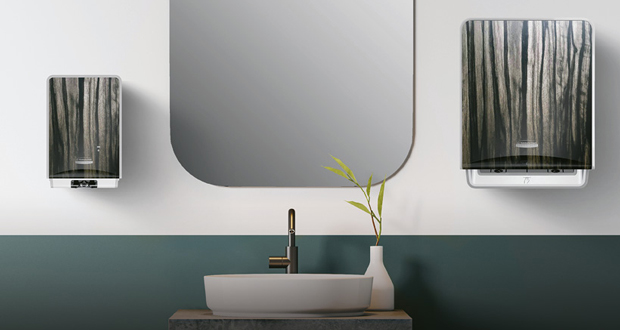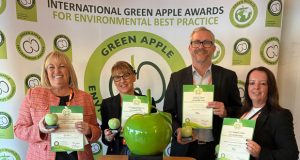 Amy Carter, Customer Marketing Manager, Washroom & Sustainability, Kimberly-Clark on the innovations which are driving the washroom towards zero waste
Amy Carter, Customer Marketing Manager, Washroom & Sustainability, Kimberly-Clark on the innovations which are driving the washroom towards zero waste
Reducing waste and promoting sustainability is increasingly vital for organisations, particularly in high-use areas like washrooms. This means facilities managers, who are typically tasked with overseeing washrooms need to adopt sustainable practices that limit the environmental burden of waste ending up in landfills or incinerated.
Waste from industrial washrooms includes paper towels, soap dispensers, plastic and metal components, and more. This waste contributes significantly to landfill mass if not properly managed, posing both environmental and logistical challenges. For FMs, balancing hygiene standards and sustainability in washrooms requires innovative solutions that tackle waste from production through disposal, integrating recycling and reusability into everyday operations.
Recycling is one solution, but beyond that, manufacturers are increasingly shifting toward a circular economy mode – a concept whereby products are designed from the outset to be reused, refurbished, and recycled.
CIRCULARITY IN WASHROOMS
The circular economy model is reshaping how manufacturers approach product design. Rather than products reaching end-of-life after a single use, circular economy principles emphasise designing products for durability, repairability, and recyclability. This model aims to keep materials in circulation for as long as possible, reducing the demand for virgin resources and minimising waste.
In the context of washrooms, this involves designing dispensers, paper products, and other supplies with reuse and recycling in mind. Kimberly-Clark has embraced this model, incorporating sustainability into every phase of the product lifecycle. The company conducts life cycle assessments (LCAs) to choose the most sustainable materials and evaluate the environmental impact of products – from raw material extraction through to disposal. Using recycled or renewable materials and avoiding hazardous substances are central to this approach, ensuring that products contribute to waste reduction without compromising quality.
TAKING CARE OF HARD-TO-RECYCLE ITEMS
Addressing washroom waste is the RightCycle™ Programme. It enables companies to recycle previously hard-to-recycle items, such as used paper towels and dispensers, which could otherwise end up in landfill.
Used dispensers and paper towels are collected at a customer’s site and are then the materials are sorted and processed by recycling partners. Plastic components are cleaned, shredded, and reformed into new products, while metal parts are repurposed. Even paper towels are recycled back into new paper-based products, creating a closed-loop system.
The programme allows facilities to reduce waste by up to 25 per cent and increase recycling rates by up to five per cent This not only helps companies meet their sustainability goals but also provides FMs with a practical way to manage washroom waste responsibly. By turning waste products into valuable raw materials, schemes like these are helping businesses contribute to a circular economy while reducing their environmental footprint.
INNOVATION BENEFITS
Innovation that optimises both product use and energy efficiency, supports FMs in reducing their washroom waste and operating costs. For example, the Kimberly-Clark ICON™ dispenser offers 150,000 dispenses per battery, reducing energy usage and waste related to frequent battery replacements. Direct drive technology brings 99.9 per cent reliability significantly reducing paper jams, which can lead to wasted paper and increased maintenance.
![]() Dual sensors allow facilities to control towel length, so businesses can cut waste by dispensing only as much as necessary. This level of control not only reduces paper waste but also helps FMs manage costs and improve user experience, as the solution is 85 per cent quieter than other units.
Dual sensors allow facilities to control towel length, so businesses can cut waste by dispensing only as much as necessary. This level of control not only reduces paper waste but also helps FMs manage costs and improve user experience, as the solution is 85 per cent quieter than other units.
WATER CONSERVATION
A critical aspect and opportunity for the washroom is water conservation. FMs must consider water-saving devices and fixtures to ensure washrooms are environmentally responsible. There are many products and fittings that can help to save water. For example, low-flow faucets, automatic shut-off systems, and touchless dispensers can all contribute to reducing water usage in washroom environments.
By saving water an FM can also minimise both operational costs, relieve maintenance issues and the environmental impact of water waste. More and more washroom solutions providers are integrating water-saving principles into product design and systems by ensuring dispensers are compatible with touchless operations, reducing unnecessary water flow and enhancing hygiene for users.
THE BUSINESS CASE FOR SUSTAINABLE WASHROOMS
Businesses and organisations aren’t just embracing the circular economy because it is good for the environment. It also makes good business sense.
Circular economy practices offer both environmental and economic benefits. Reducing waste and maximising the use of recycled materials decrease the energy required for production and help companies save on disposal costs. For businesses, sustainable washroom solutions contribute to their wider net zero or ESG (environmental, social and governance) goals and improve brand image among increasingly eco-conscious consumers.
The path to zero waste in washrooms is evolving with each innovation. As companies adopt circular economy principles, they’re not only reducing their environmental impact but also setting new industry standards.





